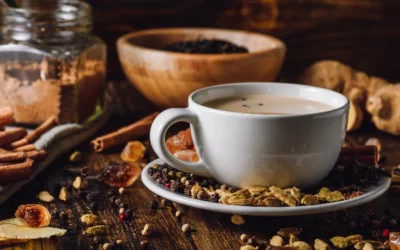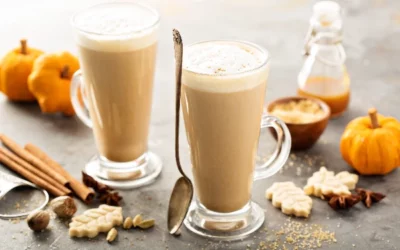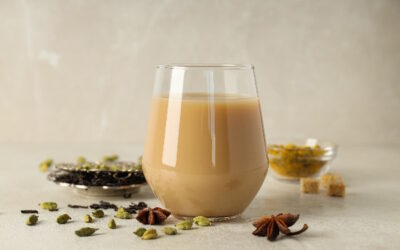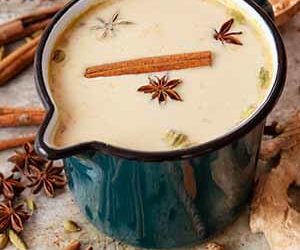If you’re a chai latte lover, you might be wondering about the calories in your favourite drink. Understanding its nutritional details can help you make informed choices and tailor your beverage to fit your lifestyle. In this article, I’ll take you through the calorie content of a standard chai latte, discuss how various factors influence its calorie count, and share tips on how you can enjoy a healthier version at home. Whether you’re health-conscious or simply curious, you’ll find valuable insights and comparisons that can help you savour your chai lattes with confidence. Let’s dive in!
Table of Content
- What is the calorie content in a standard chai latte?
- What factors affect the calorie count in chai lattes?
- How do different types of milk impact the calorie count?
- What are the health implications of consuming chai lattes regularly?
- How does the calorie count in chai lattes compare to other beverages?
- What tips can help reduce the calorie count in chai lattes?
- Are there any low-calorie alternatives to traditional chai lattes?
- How can you make a healthier chai latte at home?
- Conclusion
What is the calorie content in a standard chai latte?
A standard chai latte is packed with flavours that range from spicy to sweet. On average, a chai latte contains around 200 to 300 calories per serving. The calorie content can vary based on the type of milk used and the amount of sweeteners added. Knowing what’s in your chai latte can help you better understand its nutritional value.
Chai lattes typically include a blend of black tea, milk, and spices like cinnamon, cardamom, ginger, and cloves. Sweeteners like honey or sugar add to the calorie count. With a delicious mix of ingredients, it’s no wonder that a chai latte is a popular choice for many.
How many calories are in a standard chai latte?
The calorie content in a standard chai latte can fluctuate. On average, you can expect it to range between 200 to 300 calories per 12-ounce serving. The ingredients play a significant role in this variation.
- Black Tea Base: Usually contributes minimal calories.
- Milk: Whole milk adds more calories than skimmed or plant-based options like almond or oat milk.
- Sweeteners: Sugar, honey, or syrup usually add the majority of the calories.
- Spices: Cinnamon, cardamom, and other spices add negligible calories but plenty of flavour.
- Add-ons: Some people add whipped cream or flavour syrups, which significantly increase the calorie count.
Different ingredients impact the overall caloric value. If you’re using whole milk, you’ll end up with more calories compared to skimmed or plant-based alternatives. Sugars, honey, and syrups also play a crucial part in determining the calorie count.
What are the main ingredients contributing to the calorie count?
Understanding the ingredients of your chai latte can help make informed choices. The primary elements add unique characteristics and influence the overall caloric value.
- Milk: Whole, skimmed, almond, soy, or oat; each type offers different calorie amounts.
- Sweeteners: Sugar, honey, or flavoured syrups can significantly add to the calorie count.
- Tea Base: The black tea contributes negligible calories but enhances the antioxidant profile.
- Spices: Cinnamon, cardamom, ginger, and cloves contribute almost no calories but add deep flavour.
Your choice of milk and sweeteners most notably affect your drink’s calorie content. Opting for a less sugary version and switching to lower-calorie milk can make your chai latte much healthier.
How does the serving size affect the calorie content?
Serving size plays a huge role in determining the total calories you consume. A larger serving means more milk and sweeteners, which clearly translate to higher calories.
- Standard 12 oz serving: Roughly 200 to 300 calories.
- Small 8 oz serving: Usually falls between 150 to 200 calories.
- Large 16 oz serving: Can range from 300 to 400 calories or more.
- Customisations: Adding whipped cream, additional syrups, or more sweeteners can lead the calorie count to soar.
When you opt for a larger cup, it’s important to know that the calorie count will rise accordingly. Customising your chai latte with extra toppings will also add to your daily calorie intake.
During the British Raj era in India, chai was an essential part of daily life. The British were primarily responsible for popularising tea drinking in India, blending strong black tea with local spices, eventually leading to what we know today as chai.
Milk and sweeteners were later additions that transformed chai into the beloved chai latte. The fusion of British and Indian tea practices gave birth to this globally cherished beverage.
What factors affect the calorie count in chai lattes?
Understanding the calorie count in a chai latte is important, especially if you’re conscious about your daily intake. Several factors influence this number, and knowing them can help you make healthier choices. These include the type of milk, amount of sugar or sweeteners, additional ingredients, and the size of the drink.
When exploring these factors, it becomes evident that even slight changes can significantly impact the calorie content. For instance, choosing almond milk over whole milk or opting for a smaller size can make a big difference.
Type of milk used
The type of milk you choose greatly affects the calorie count in a chai latte. Different milks have varying fat and sugar content:
- Whole Milk
- Skim Milk
- Almond Milk
- Soy Milk
- Oat Milk
- Coconut Milk
- Cashew Milk
Each of these options adds a unique flavour and nutritional profile to the drink. For those seeking lower calories, non-dairy alternatives like almond or soy milk are popular choices.
Amount of sugar added
Sugar greatly influences the calorie content. Sweetened chai lattes naturally have higher calorie counts than those made without added sugars. Here are the typical ranges:
- No Added Sugar
- Light Sugar (1 teaspoon)
- Regular Sugar (2 teaspoons)
- Extra Sugar (3 teaspoons)
Reducing sugar or opting for natural sweeteners can make the drink healthier without sacrificing too much of the enjoyable taste.
Use of sweeteners
Instead of sugar, some prefer sweeteners, which also alter the calorie count:
- Artificial Sweeteners (like sucralose or aspartame)
- Natural Sweeteners (like Stevia or honey)
Artificial sweeteners often provide a sweet taste with no or few calories, while natural ones may add some but usually fewer calories than traditional sugar.
Presence of additional ingredients
Add-ons like whipped cream, flavoured syrups, or toppings further change the calorie content:
- None
- Whipped Cream
- Vanilla Syrup
- Caramel Drizzle
- Cinnamon Powder
Each topping brings extra flavour and calories. It’s crucial to consider these extras when calculating your drink’s total calorie count.
Size of the drink
The size of your chai latte (in ounces) directly impacts its calorie count:
- Small (8 oz)
- Medium (12 oz)
- Large (16 oz)
- Extra Large (20 oz)
Larger sizes naturally contain more milk, sugar, and flavourings, resulting in higher calorie counts.
Factors affecting the calorie count in chai lattes
| Factor | Whole Milk | Skim Milk | Almond Milk | Soy Milk | Oat Milk | Coconut Milk | Cashew Milk |
|---|---|---|---|---|---|---|---|
| No Added Sugar | 180 | 100 | 60 | 130 | 120 | 70 | 60 |
| Light Sugar (1 tsp) | 205 | 125 | 85 | 155 | 145 | 95 | 85 |
| Regular Sugar (2 tsp) | 230 | 150 | 110 | 180 | 170 | 120 | 110 |
| Extra Sugar (3 tsp) | 255 | 175 | 135 | 205 | 195 | 145 | 135 |
| Whipped Cream | +60 | +60 | +60 | +60 | +60 | +60 | +60 |
| Vanilla Syrup | +50 | +50 | +50 | +50 | +50 | +50 | +50 |
| Caramel Drizzle | +60 | +60 | +60 | +60 | +60 | +60 | +60 |
| Cinnamon Powder | +5 | +5 | +5 | +5 | +5 | +5 | +5 |
| Small (8 oz) | 80 | 50 | 35 | 60 | 55 | 35 | 30 |
| Medium (12 oz) | 120 | 75 | 50 | 90 | 85 | 55 | 45 |
| Large (16 oz) | 180 | 100 | 75 | 130 | 120 | 70 | 60 |
| Extra Large (20 oz) | 220 | 140 | 90 | 170 | 150 | 90 | 75 |
Use this table to choose the type of milk and the extras that best fit your dietary needs. By combining these elements thoughtfully, you can tailor your chai latte’s calorie count to your preferences.
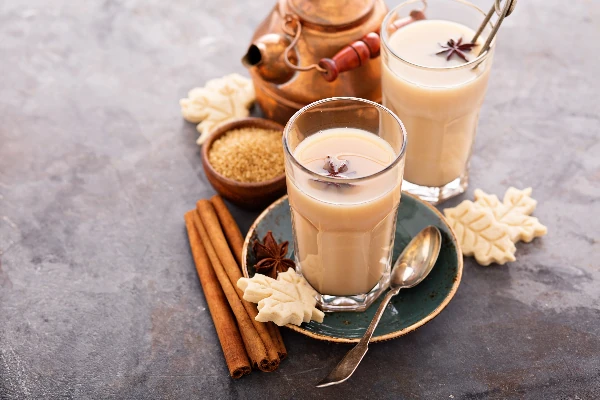
How do different types of milk impact the calorie count?
Alright, mate, you’re sipping on that chai latte every morning like it’s your lifeline. It’s time to get real about what those different types of milk are doing to the calorie count of your precious cup of chai.
Here’s the thing: the type of milk you use makes a massive difference. It’s like swapping a racing car’s engine; the body stays the same, but your performance changes dramatically. Let’s break it down, almost like dissecting that math problem you pretended not to understand in school.
How does whole milk affect the calorie count?
So, let’s start with the big leagues – whole milk. Imagine you’re adding a touch of luxury to your chai.
- Whole milk is the rich and creamy villain here, coming in at roughly 149 calories per cup (240 ml).
- It’s got around 8 grams of fat which isn’t exactly your waistline’s best friend.
- On the upside, it’s packed with protein (8 grams) and calcium, but we’re talking calories, so those perks are just a consolation prize.
- Using whole milk makes your chai latte creamy and, well, a bit of a decadent treat.
Whole milk is like inviting your most indulgent friend to a party. It’s fun but, oh boy, do you regret it later when you try to fit into those jeans.
What is the calorie difference when using almond milk?
Now, let’s switch gears to almond milk. Think of it as the health-conscious cousin who always talks about their latest yoga retreat.
- Almond milk comes in feather-light at 30-40 calories per cup.
- It’s hardly got any fat, with just 2.5 grams or so.
- There are only about 1 gram of protein, so it’s not the most filling option.
- You might miss the richness of whole milk, but calorie-wise, you’re sitting pretty.
Almond milk is like that friend who always eats salads. Less exciting, sure, but you can’t argue with the results.
Are there significant calorie changes with oat milk?
Finally, oat milk. This one is the flavourful rebel, trying to balance taste and mild indulgence.
- It’s a bit more indulgent than almond milk at about 120 calories per cup.
- It carries around 5-7 grams of fat.
- And has a decent 3-4 grams of protein.
- Oat milk gives a creamy texture without being a calorie bomb.
Oat milk is your middle-ground mate. Not too heavy, not too light – just right for when you’re trying to be good but still want to enjoy life.
So, my friend, the type of milk you choose for your chai can make a huge difference to your calorie tally without changing your drink dramatically. Choose wisely, and your morning cup of sunshine will still fit into that healthy diet you swear you’re sticking to.
Consider this historical titbit: during World War II, milk – particularly whole milk – was rationed in the UK. People had to make do with powdered milk alternatives, which were significantly lower in calories and nutrients.
This not only affected their daily energy intake but also led to various nutritional deficiencies. Despite the shortage, the British still found a way to keep their beloved tea-time rituals alive, showing the enduring power of a good cup of tea, or in your case, a chai latte.
It’s fascinating how even the type of milk we choose can tell a story about our times and choices.
What are the health implications of consuming chai lattes regularly?
So, you’re hooked on chai lattes? Join the club! But, ever wondered what downing these spiced delights on the reg does to your health? Spoiler alert: it’s not all rainbows and unicorns. Let’s break down the dirty deets: calories, sugar, and more nutrition facts than you probably cared to know.
Ah, the beloved chai latte. A frothy mix of black tea, milk, and spices that’ll make you feel like you’re on a mini-vacation. But it’s not all sunshine and roses. That aromatic cup can pack a sneaky punch, both good and bad. We’re talking sugar bombs and calorie counts, buddy. So, strap in and let’s spill the tea—literally.
What are the potential health benefits of chai lattes?
Let’s start on a high note, shall we? Before we get all doomsday about the sugar, let’s appreciate the good stuff.
Potential health perks:
- Antioxidants Galore: Thanks to the black tea, chai lattes are a mini fountain of youth. They help combat oxidative stress and keep those pesky free radicals in check.
- Anti-Inflammatory Effects: The spices like ginger and cinnamon aren’t just for taste; they bring some anti-inflammatory action to the table.
- Mood Booster: The combo of caffeine and the delightful spice mix can give you that sweet serotonin boost. Instant happiness in a mug.
- Digestive Aid: Ginger’s a hero for your gut. It can help with digestion and keep nausea at bay.
- Heart Health: Believe it or not, some studies suggest that the compounds in black tea might help lower blood pressure. So, cheers to a healthier ticker!
Sounds pretty fab, right? But hold your horses; it’s not all smooth sailing.
Okay, so sipping on chai lattes could improve your health in some ways. But be warned, too much of a good thing can lead to some avoidable pitfalls!
What are the risks of high sugar intake from chai lattes?
Brace yourself—those sugary swirls in your chai latte aren’t doing your waistline any favours.
Sugar sneaky snares:
- Weight Gain: You may love the sweetness, but your waistline won’t. Sugar equals extra calories, and we all know where that leads.
- Blood Sugar Spikes: That sugar’s going to hit you like a truck, causing spikes and crashes, making you feel miserable and craving even more.
- Tooth Decay: Sugar and teeth are like oil and water. Enjoy your chai latte, but don’t forget to brush, or your dentist will become your new BFF.
- Increased Risk of Chronic Diseases: Hello, diabetes and heart disease. Too much sugar can escalate your risk for these long-term health issues.
- Nutrient Depletion: High sugar intake can impair your body’s ability to absorb essential nutrients, making you feel sluggish and unwell.
Yikes, right? Those sugar-packed chai lattes can derail even the best health regimes.
Not all hope is lost, though. You can still sip your favourite drink without turning into a sugar zombie. Moderation is your friend here.
How can chai lattes fit into a balanced diet?
Chai lattes don’t have to be your nutritional kryptonite. With a few tweaks, you can enjoy them without the guilt trip.
Make your chai latte diet-proof:
- Go Light on Sugar: Ask for less syrup or choose sugar alternatives like stevia. Your taste buds will adjust.
- Opt for Skimmed or Plant Milk: Almond, soy, or even oat milk can cut down on calories and fat—without sacrificing the foam.
- DIY at Home: Control the ingredients, portion sizes, and sugar levels by making your own at home.
- Switch It Up: Alternate between chai lattes and other lower-calorie drinks to keep your palate and calorie count balanced.
- Watch Portion Sizes: A small cup can be just as satisfying as a large, drastically reducing your calorie and sugar intake.
Balance is the key. You can, indeed, have your chai and drink it too.
Alright, time for a little history lesson. Picture this: It’s the 1800s, British India. The British colonisers were obsessed with introducing tea to the local population. They even offered it free at railway stations (talk about early marketing!).
But the locals? They added spices, milk, and sugar, creating what we now call chai. That’s right, your favourite latte is actually a product of two cultures fusing together over a cup of tea. One could say it was a spicy collision of worlds—literally.
How does the calorie count in chai lattes compare to other beverages?
Ever wonder how that delectable chai latte stacks up calorie-wise to other beloved beverages? It’s like comparing apples to oranges, except in this case: coffees, smoothies, soft drinks, energy drinks, and hot chocolate. So, strap in – we’re about to break down the calorie counts without all the fluff, just facts and a sprinkle of sarcasm.
Chai lattes generally ride the calorie wave somewhere between “not too bad” and “oops, did I just drink half my daily calories?” On average, a 12-ounce chai latte can pack about 200-300 calories, depending on how fancy or sugary it gets. Sounds like your worst enemy? Well, let’s check out how it shapes up against other sips.
How does a chai latte’s calorie count compare to a latte?
When you think of a latte, think of it like the chai latte’s cousin who’s just a tad more pretentious. A basic latte has around 150-200 calories for the same 12-ounce serving, mostly thanks to the milk. No spices, no frills – just milk and espresso.
- Chai Latte: 200-300 calories
- Regular Latte: 150-200 calories
- Whole milk lattes can climb above 200 calories
- Almond milk lattes drop down to around 100-150 calories
- Add a syrup or two, and watch those numbers go up
So, in the battle of the lattes, the regular latte might have a slight edge, but it really depends on how you take your chai. Swap full-fat milk for almond milk and you’re almost neck and neck.
What are the calorie differences between chai lattes and smoothies?
Smoothies are like the Jekyll and Hyde of beverages. They can be calorie bombs or healthy wonders, depending on what goes into the blender.
- Naked Smoothie (approx. 270 calories for 12 ounces)
- Homemade kale and spinach smoothie (approx. 100-150 calories)
- Smashed banana and peanut butter smoothie (approx. 250-400 calories)
- Jamba Juice’s offerings (200-500 calories – no kidding!)
So, if you’ve got a chai latte and a creamy peanut-butter-monster smoothie, the chai wins hands down as the lower calorie option. But if you’re sipping on a green health elixir, the chai might look a tad indulgent.
Are chai lattes healthier than soft drinks?
Soft drinks are the sugar devil in a can. A 12-ounce cola sets you back about 140-150 calories, with no nutritional benefits, just sugar, and more sugar.
- Cola: 140-150 calories
- Sprite: 140 calories
- Dr Pepper: 150 calories
- Chai Latte: 200-300 calories
Sure, a chai latte has more calories, but it also brings some spices, maybe a touch of antioxidants, and a sense of sophistication. Soft drinks, on the other hand, bring nothing but regret and a sugar crash.
In our historical exploration, let’s talk about King Charles II of England, who would definitely fancy a chai latte over a boring cola. Back in the day, Charles was quite the trendsetter, bringing back tea from Asia. Having a chai spiced version would probably have made his elegant soirees the talk of the town even more. So next time you sip on your creamy chai, think of it as keeping up with centuries-old royal tradition, just minus the throne and sceptre.
And there you have it – chai lattes vs. the world. Choose wisely!
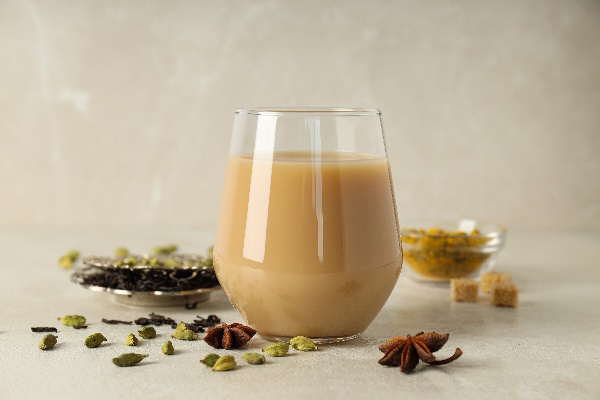
What tips can help reduce the calorie count in chai lattes?
If you’re a chai latte enthusiast who wants to enjoy the spice without the spare tyre, there are a few tricks you can use to cut those calories. Now, before you clutch your cup in panic, rest assured you won’t have to give up your treasured drink. From swapping out ingredients to controlling portions, let’s dive into the world of slimming down your chai latte.
First, we’ll cover some pointers for cutting calories. Opt for low-fat milk, cut back on sugar, and use natural sweeteners. And don’t forget the portion size and healthier toppings.
How can switching to low-fat milk reduce calories?
Right, folks, this one’s a no-brainer. Your classic chai latte is often swimming in full-fat milk, which is delicious but calorie-packed. Switching to low-fat milk is a simple way to trim those numbers without sacrificing taste.
- Low-fat milk contains fewer calories than its full-fat counterpart.
- Reduced fat means less cholesterol, keeping your heart happier.
- Lower in saturated fat, which your waistline will appreciate.
- Still provides essential nutrients like calcium and protein.
- Makes your chai latte lighter but just as frothy.
This swap impacts the texture and adds a certain lightness to your cup of chai. If you’re feeling adventurous, plant-based options like almond or oat milk are excellent choices as they come with their own set of nutritious benefits.
What are some natural sweeteners to use?
There’s no denying the joy of a sugar-laden chai latte, but your body might not be singing the same tune. Luckily, there are natural alternatives that can sweeten the deal without ramping up the calorie count.
- Honey offers a sweet touch, plus antioxidants.
- Agave syrup provides sweetness but with a lower glycaemic index.
- Stevia is a zero-calorie option derived from plant leaves.
- Maple syrup adds a distinct flavour with fewer calories.
- Coconut sugar has a rich, caramel taste but less refined sugar.
Using these sweeteners means you get to enjoy the sweet taste minus the guilt. Plus, they each bring their unique flavours and benefits to the table, making your chai experience a tad more interesting.
How does portion control help manage calorie intake?
Let’s face it, size does matter, particularly when it comes to your chai latte. You can switch to all the low-calorie options you want, but if you’re guzzling bucket-sized lattes, you’re still overdoing it. Portion control is key.
- Smaller cups mean fewer calories overall.
- Less liquid means fewer additional toppings and sugars.
- Smaller portions lead to more mindful drinking.
- It helps in balancing other calorie intake throughout the day.
- Encourages savoury sips rather than hasty gulps.
Portion control doesn’t mean you’re punishing yourself. It means you’re savouring each sip and enjoying your favourite drink in moderation.
In the 19th century, under the reign of Britain, tea was the kingly beverage of choice. Soldiers stationed in India left their mark on local culinary traditions, popularising what we now know as chai.
However, the original version was a blend of tea leaves and milk, minus the added sugars and calories. This goes to show that sometimes, looking to the past can offer tasty solutions to modern issues. By revisiting these simpler, wholesome recipes, you can enjoy your chai latte without the runaway calorie count. Cheers to that!
Are there any low-calorie alternatives to traditional chai lattes?
So, you’re a chai latte fanatic but also watching those calories, huh? It’s like being trapped between a rock and a hard place, but don’t worry—I’ve got your back. Let’s dive into some delicious yet low-calorie alternatives that still give you that cozy feeling without the calorie overload.
What are some herbal tea alternatives?
Alright, step one: broaden your horizons beyond the traditional chai latte. Herbal teas are like the cool, health-conscious cousins of chai lattes. They’re not just for the hippies or yoga instructors anymore.
- Rooibos Tea: Zero calories and a sweet, nutty flavour that’s almost like dessert in a cup.
- Peppermint Tea: Another zero-calorie option with a refreshing kick that’ll clear your sinuses and your conscience.
- Hibiscus Tea: Fruity, tangy, and totally free of calories. It’s basically Kool-Aid for adults.
- Chamomile Tea: Perfect for mellowing out. Zero calories and great for relaxation.
- Ginger Tea: Spicy and invigorating, all while being calorie-free.
See? You don’t have to sacrifice flavour while dodging those extra calories.
How does chai tea with water compare in calories?
Next up, if you’re not ready to completely abandon chai, let’s get creative with how you make it. Simply swap the milk for water, and voilà! A dramatic calorie drop.
- Traditional Chai Latte with Milk: You’re looking at roughly 200 calories, and that’s assuming you’re using regular milk. Add some syrup, and you’re toast.
- Chai Tea with Water: Basically, we’re talking around 30 calories per cup, mainly from the spices and tea.
That’s a whopping difference! And if you’re worried about missing out on creaminess, add a splash of almond milk—it’s low-calorie and still tasty.
Are iced chai lattes a lower-calorie option?
Think swapping to iced will save you calories? Not necessarily, but let’s break it down.
- Iced Chai Latte with Milk: Similar calorie content to the hot version, around 200 calories, especially with the syrups and milk still in play.
- Iced Chai Latte with Alternative Milk: Sub in almond or oat milk to trim down the calories. You can shave off 50 to 100 calories, depending on your choice.
- Iced Chai with Just Water: Again, all the spicy goodness with minimal calories, around 30-50.
This option’s great for those hot summer days when you still crave your spicy fix without the guilt.
Moving towards low-calorie chai alternatives doesn’t mean you’re compromising on taste. Whether you make simple swaps or try something new, there are endless options.
Back in the 1600s, when tea first made its grand entrance into British society, it was considered a mere curiosity. Fast forward a few centuries, and now it’s a daily ritual for many. Lady Catherine of Braganza, who married King Charles II, is often credited with popularising tea in Britain.
Imagine having to drink tea that wasn’t even your cup of tea (pun totally intended) and then transforming it into an empire’s favourite pastime. Now, if a Portuguese princess could convert an entire nation, surely you can shift to a lower-calorie chai latte alternative without any fuss. Cheers to making history—and healthier choices.
How can you make a healthier chai latte at home?
Ever felt a twinge of guilt after your third chai latte of the day and wondered how many calories you just gulped down? You’re not alone. But fear not, there’s a way to enjoy your favourite spicy drink without turning into a human sugar cube.
Making a healthier chai latte at home is more straightforward than you might think. And yes, you can still keep that delicious flavour. The trick is in the ingredients, how much sugar you add, the spices you choose, using milk alternatives, and adjusting those pesky portion sizes.
Let’s dive straight into the heart of the matter: the roadmap to a healthier mug of chai latte.
What ingredients should you choose for a healthier chai latte?
Ingredients make all the difference. Swap out the calorie-laden stuff for some healthier options and you’re halfway there. Here’s how:
- Tea Base: Use high-quality black tea or opt for green tea if you’re feeling fancy.
- Sweeteners: Natural sweeteners like honey, stevia, or agave are your friends.
- Milk: Go for skimmed milk or try plant-based alternatives like almond, soy, or oat milk.
- Spices: Fresh, whole spices give more flavour and pack in nutrients without adding calories.
- Extras: Avoid adding whipped cream or flavoured syrups, which just pile on extra calories.
Replace the regular suspects with these healthier choices, and watch your chai latte transform into a guilt-free beverage.
How can you control the amount of sugar added?
Sugar, the silent saboteur of your calorie count, needs to be kept in check. Here are some simple strategies:
- Measure: A teaspoon of sugar here and there adds up. Use a measuring spoon to keep track.
- Natural Sweeteners: Honey, stevia, or agave offer sweetness without the same calorie hit as table sugar.
- Spice It Up: Many spices like cinnamon and vanilla have natural sweetness. Use these to reduce the need for added sugars.
- Taste First: Sometimes a sip might reveal you don’t need as much sugar as you thought.
- Gradual Reduction: Slowly reduce the sugar you add over time, and you might not even notice the difference.
By taming the sugar beast, you’re already making your chai latte significantly healthier.
What are some spice combinations to try?
The right spice mix can elevate your chai latte from mundane to magical, without piling on calories. Here are some spice combos to jazz up your drink:
- Classic: Cardamom, cinnamon, ginger, and cloves.
- Warm and Cozy: Nutmeg, allspice, star anise.
- Floral: Lavender and vanilla.
- Citrusy: Orange zest, lemon verbena.
- Exotic: Turmeric, black pepper, saffron.
These spice combinations add depth and flavour, making you wonder why you ever ate those bland lattes in the first place.
Flashback to 1830s India, where British soldiers stationed there got a taste of “masala chai” from local vendors. Initially, the workers consumed it for energy and its believed health benefits. Fast forward to today, and you can still honour this tradition by savouring your homemade, healthier chai latte, minus the sugar overload. Cheers to a lighter, brighter version of this historical delight!
Conclusion
As I reflect on the journey through the calorie content of chai lattes, it’s clear that understanding this beloved beverage extends far beyond the simple enjoyment of sipping it. We’ve delved into the average calorie count, with variations shaped by ingredients, serving sizes, and preparation methods. With this knowledge, it becomes evident that the choice of milk—whether it’s whole, skim, almond, or oat—and the amount of sugar or sweeteners used can dramatically shift the caloric landscape of our chai delights.
This exploration not only highlights the importance of making informed choices but also encourages a mindful approach to our dietary habits. The implications of incorporating chai lattes into our everyday lives might raise some questions, notably concerning sugar intake and overall nutritional balance. If nothing else, I hope to inspire you to think critically about what goes into your cup and how it fits into your broader dietary patterns.
Moving forward, consider the tips we discussed for reducing calorie counts, exploring low-calorie alternatives, and making healthier versions at home. By experimenting with natural sweeteners, controlling portion sizes, or opting for herbal tea alternatives, you can reshape your chai experience to better align with your health goals.
In closing, remember that the choices we make regarding what we consume have the power to influence not just our health, but also our overall well-being. As I often remind myself, life is about balance—so next time you indulge in a chai latte, think of it as a delicious moment that fuels both body and spirit. After all, isn’t the essence of a good cup about not just calories, but also comfort and community? What will you choose to pour into your own cup today?


